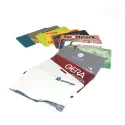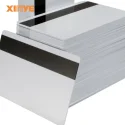2023-01-10
At its most basic, RFID consists of three components: a reader, a tag, and an antenna. The reader emits radio waves that activate the tag, which is typically a microchip with an attached antenna. The tag responds by transmitting its unique identifier (ID) back to the reader. This ID can be used to store and retrieve information about the tag and the item it is attached to.
There are two main types of RFID tags: passive and active. Passive tags do not have their power source and rely on the reader to supply power through the radio waves. Active tags, on the other hand, have their power source and can transmit their ID over longer distances than passive tags.

Benefits of RFID
One of the key benefits of RFID is its ability to automate the tracking and identification of items. This can greatly improve efficiency and accuracy in supply chain management, inventory control, and asset tracking. RFID can also help reduce the need for manual data entry and reduce the risk of errors.
In addition, RFID can provide real-time tracking and visibility of items, which can be especially useful in industries such as transportation and logistics. This can help improve delivery times and reduce the risk of lost or damaged goods.
Limitations of RFID
While RFID has many potential benefits, it is important to note that it also has some limitations. One potential issue is the cost of implementing an RFID system, which can be significant depending on the size and complexity of the system. In addition, RFID tags can be vulnerable to interference from other electronic devices and may not work properly in certain environments.
Another limitation of RFID is that it requires some level of infrastructure, including RFID readers and antennas. This can be a challenge for businesses that do not have the necessary resources or space to install the necessary equipment.
Applications of RFID
RFID technology has a wide range of applications across many different industries. Some common uses of RFID include:
Supply chain management: RFID can be used to track the movement of goods through the supply chain, from raw materials to finished products. This can help improve efficiency and reduce the risk of errors.
Inventory control: RFID can be used to automatically track and update inventory levels, reducing the need for manual data entry and improving accuracy.
Asset tracking: RFID can be used to track and manage the movement and maintenance of assets, such as equipment and vehicles.
Retail: RFID can be used to track and manage inventory in retail stores, as well as to improve customer experience through personalized recommendations and targeted promotions.
Healthcare: RFID can be used to track and manage medical equipment, as well as to improve patient safety by automating the tracking of medications and other supplies.

In conclusion, RFID technology has the potential to greatly improve efficiency and accuracy in a variety of industries. While there are some limitations to consider, the Maximizing the Benefits of RFID Technology in Your Business.
Xinye has a deep understanding of the use of RFID smart cards and RFID tags in various application scenarios and can provide design ideas, production services, and technical support for smart cards and RFID tags in various industries. If your enterprise is looking for RFID products, you can also visit our website https://www.xinyerfid.com. Pls feel free to contact us!
Categories
Title with button
this is a new beginning
We provide all your needed for starting your own online business, and even easier. Establish an online store, Oceans of Products Supply, Integrate Logistics Solution & Comprehensive After-sale Services.




